Air launch is a promising way to launch spacecraft from airplanes. Theoretically, it should significantly reduce the cost of launching and make the procedure much more flexible and faster. But as decades of development in this area have shown, it’s not that simple.
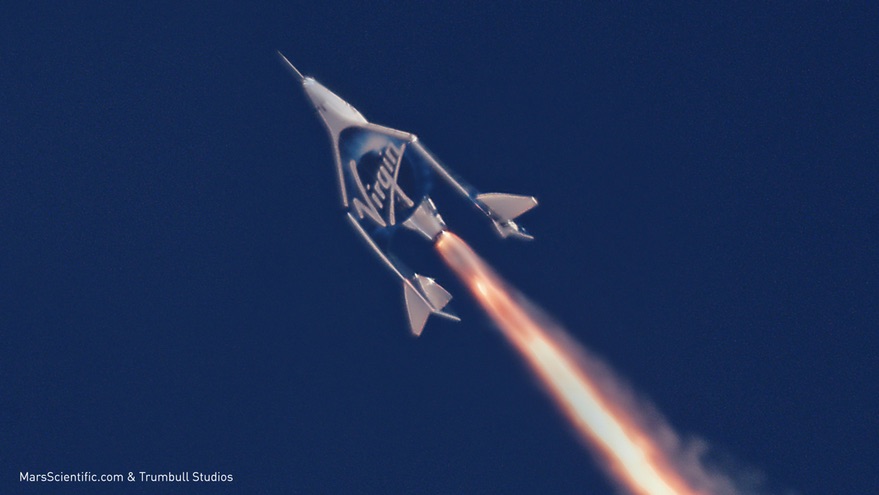
Problems with ground launch
A rocket is an extremely irrational design. It sounds rather strange, doesn’t it? But let’s analyze it.
The main drawback of a rocket is that it carries an oxidizer. In many cases, it’s the same oxygen that we have all around us. The same oxygen that almost all living beings use for free, as well as almost all thermal engines (and electric engines too — but indirectly, through power plants). Steamboats, diesel locomotives, cars, airplanes — all are powered by free oxygen. But rockets are not. They have to store oxygen or another oxidizing agent in tanks — expensive cryogenic tanks — and not only carry it up, but also accelerate to escape velocity!

The reason is simple: there is almost no oxygen above twenty to thirty kilometers… and you have to fly somehow.
That’s why almost everyone who has ever dealt with space launch vehicles, or even been interested in them, sooner or later asks those questions: “Why not save money? Why not lift the rocket to an altitude of 10-20 km using atmospheric oxygen? Or even without using it — just lift it up? Or even accelerate it by adding the speed of the carrier aircraft to the orbital speed? It would be cheaper!”
Why is an air launch not as profitable as it seems?
No, it won’t be cheaper. Moreover, it’s very likely it won’t work at all.
Why is that? Let’s do the math. Detailed technical and economic calculations are beyond the scope of this article, but the main points can be literally finger-counted.
Let’s start with the altitude. The rocket carries the cargo up to the altitude of 250-300 kilometers. A transport plane will take it up to 10-15 km, which is 3-4% of the required altitude. Thus, 3-4% of fuel and oxidizer will be saved.
Not enough.
Will it be possible to save on speed? The rocket accelerates the payload to 8 km/s. The airplane will accelerate the rocket to 200-220 m/s, i.e., to 2.7% of the required speed. It’s also not enough.
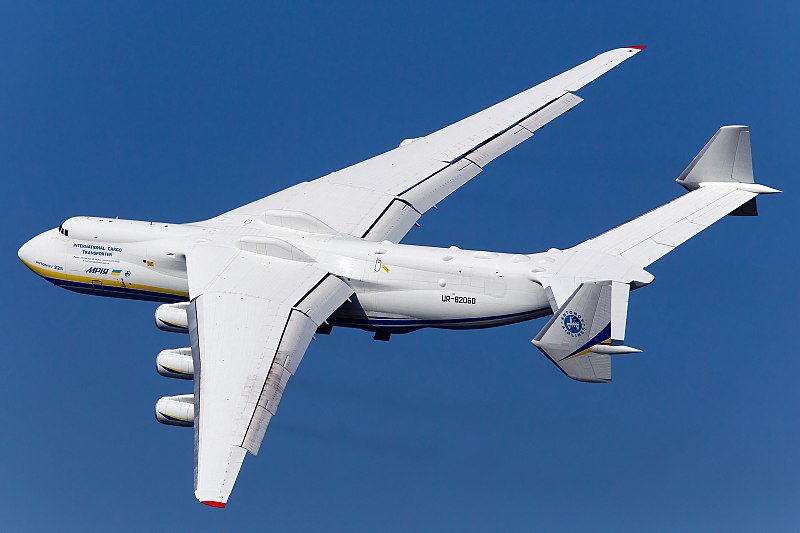
The price for this miserable savings will be high. First, the rocket will have to be limited in weight. The most powerful aircraft have a payload of 100-150 tons. The weight of the old R-7 carrier created by Korolev is 300 tons, and the Cyclone-2 launch vehicle is about 190 tons. It’s better not to mention heavyweights like Falcone 9 at all, because they won’t fit on any aircraft. There are still small carriers of light and ultralight classes weighing up to 100-120 tons, but they are cheap anyway. There is little point in saving money on them.
Secondly, the missile must be designed specifically for airplane launches, which is a rather complicated engineering task. A ground launch practically does not limit the length (or the height if you wish) of the rocket, while an airplane limits it to the size of its fuselage.
Launch structures protect the missile from wind loads (for example, the above mentioned R-7, apart from being firmly fixed with special tongs “by the neck”, is almost half hidden in a concrete well), and the missile dropped from the aircraft first enters the turbulent jet from it and is subjected to strong loads from all sides.
If the rocket is cryogenic, meaning it uses supercooled gases such as methane, hydrogen, and oxygen that evaporate intensively, it should be refueled on the ground right up to the moment of launch. The aircraft is not capable of carrying an oxygen plant with it.
Thus, the rocket for an air launch must be small (if it uses the An-124 or C-5 as a carrier, it should be no more than 36 meters long, and if it uses the the Il-72, it should be no more than 24 meters long). The diameter is also limited — no more than 5 meters. All cryogenic components are undesirable, as well as liquid fuel in general. The hull must be strong in all directions. The stabilization system must vigorously turn the rocket nose up within a few seconds. If it is done with a parachute, there must be an additional system to get it out of the way of the rocket, or it will have to be flown around somehow.
A “hot start” is a bad idea
And here you might exclaim: “But you can hang the rocket under the wing or fuselage and start the engine before it gets detached!” And you are right. It is possible. But if the rocket accident happens — for example, an explosion — the airplane will burn together with the crew. And while the risk of such a sad event is considered more or less acceptable for military purposes, it is clearly not worth destroying an airplane and killing 5-7 crew members in peacetime to launch a penny-ante light satellite.
So no, a “hot start” is an extremely bad idea.
But such projects really existed.
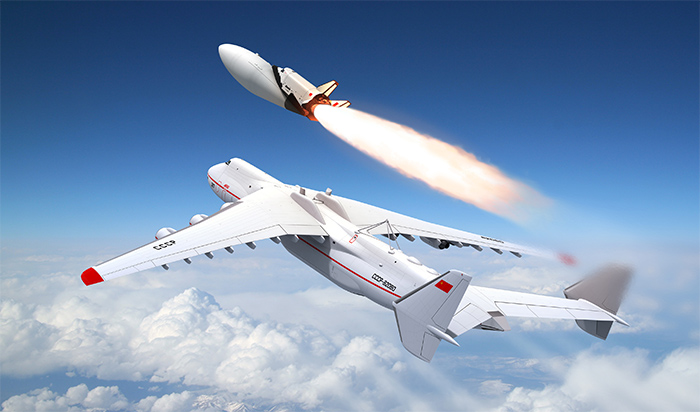
It was the Reusable Aerospace System. It was planned that the first stage would be the An-225 Mriya aircraft, and the second stage would be a manned or unmanned reusable rocket, or a disposable rocket with a payload weight of up to 18 tons.
The project is not new; it was born in the eighties of the last century. From time to time, they tried to revive it. The last known stirring in this regard took place sometime around 2008… but then Russia started “geting off its knees” and everything went dead.
However, it was a completely insane project that would have died on its own. It’s unlikely that Mriya would have survived even a single launch from its own back.
If we approach the issue realistically, then a more or less viable image of an air-launched rocket looks like that: a light (up to 100 tons), small, solid-fueled one, with a payload weight of 50-500 kg.
And here it is:

This is Pegasus. It is the only air launch system to date that has been performing serial launches. The parameters of its rocket are far from the maximum defined above: the weight is only 18-23 tons, the payload is 443 kg. It has several interesting features: for example, during the first stage of flight, it is controlled by aerodynamic controls like a conventional airplane. It is launched from a converted airliner.
In operation, it is not so good. There were 44 launches, three of them ended up failure. This is a rather poor performance. The aforementioned Cyclone-2 has flown more than a hundred times without accidents. The carrier is private and is positioned as a commercial one. The declared cost of the launch at the beginning of the program was a very tempting $6 million, but reality made its own adjustments, and in 2017 the cost was $57 million, which is a bit too much for a lightweight carrier. No customers were found for the last two copies of the rocket. Some of its parts were used in other projects, including quite interesting ones, such as the X-43A hypersonic aircraft and the GBMD anti-missile. Both projects deserve a separate story, but in the meantime, let’s recall what failed to be brought to series.
Operation Argus
One of these projects is truly impressive. We are talking about NOTSNIK. By the way, the etymology of the name is quite funny. It is made up of the abbreviation NOTS (Naval Ordnance Test Station) and the suffix -nik. Guess where this suffix came from. Here’s a hint: it’s 1957.
That’s right, from Sputnik. Shocked by the success of the Soviet launch, American engineers were frantically looking for an answer. And, as they thought at the time, they found it…
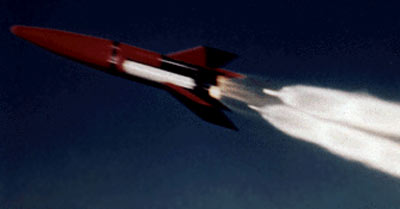
So here it is. NOTSNIK is impressive not because of its technical characteristics (there’s nothing wrong with them: they’re bad), but because of an incredible mixture of haste, adventurism, negligence, and poor flight organization. This is not possible today. It would be banned at the preliminary design stage, managers would be sued, and developers would have to change their trade to become psychotherapists or some other geeks.
The vehicle itself was a small multi-stage launch vehicle with a satellite. Since there was no time to develop engines, they decided to use existing solid-fuel rockets. There were no funds either, so the leaders resorted to outright fraud. To get funding, they officially proposed to launch a small satellite into orbit to conduct measurements during high-altitude nuclear tests. The timing was perfect: Operation Argus — a series of high-altitude nuclear explosions — was scheduled for August 1958.
The proposal came more than in time. The money was given, the aircraft was named NOTS-EV-1, and they tried to launch it. The result was predictable. Yes, all four times. During the third attempt, the pilot said he saw an explosion, and one of the ground engineers said he heard a weak radio signal from orbit. There also was also a movie camera. There seemed to be no other means of objective control.
August came and there was no progress. The device was hastily modernized, called NOTS-EV-2 Caleb and dispatched for testing. They promised it would be able to shoot down enemy satellites. The result was even more predictable than with its predecessor. Yes, all seven times.
First, they launched it with an F4D, but it was not the same F4 as the F-4 Phantom II, but a different F4 (the naming in the US is also fine: the devil himself would not immediately figure it out). Then they launched it with the F4, which is the Phantom. Some Soviet spy would have been completely confused in this place and most likely would not have reported to the Center… lest he would have been ridiculed. Perhaps the Americans were also wary of ridicule, so they kept both projects secret until the mid-nineties.

Or maybe that’s not why they were classified. It was because this and other projects eventually grew into the ASAT anti-satellite system, which is very flexible, inexpensive, effective, and successfully tested. And also is air-launched.
Farside project
But let’s get back to the topic.
NOTSNIK was not the first. A year before, another rocket was launched in the air and rose to heights that its developers could not even dream of. Why? Because the developers of that rocket were even crazier.
No exaggeration. You can’t call normal people who sculpt a missile out of whatever they can get and hope for something… No matter how many times the North Koreans tried the same thing, they always failed.
But these guys managed.
The project was called Farside, and the rocket was molded from six other experimental rockets. If there were a tradition in rocketry to write down the composition of a multi-stage rocket using a formula like that for steam trains, it would look like this:
4 x Recruit + 1 x Recruit + 4 x Arrow II + 1 x Arrow II
The rocket itself was even more terrifying.
We couldn’t find any high-quality photos, because in 1957 people didn’t have time to take a morning breakfast photo set, a dozen photos on the way to work, and the same number during lunch. But there is a good photo of a model. Here it is:
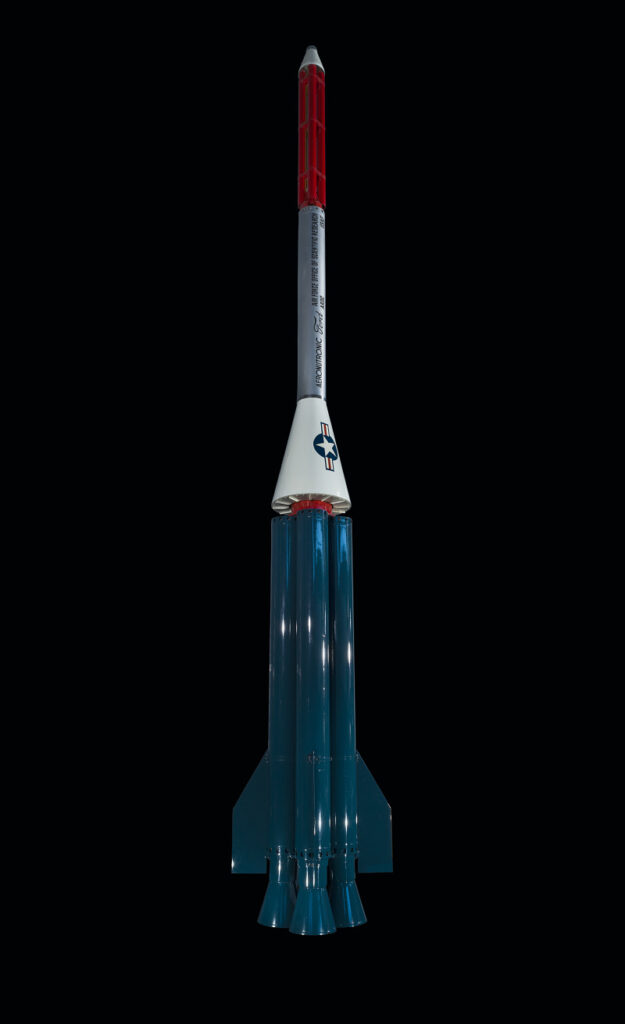
Would not you be afraid to launch something like this? Yes!
The theory of reliability tells us that the more parts a structure has, the more chances of an accident there are. The creators of Farside confirmed this thesis experimentally: out of six launches, four failed, mostly due to the failure to ignite some of the rockets. But the two that succeeded… well, they succeeded. They reached an altitude of 5,000 kilometers, which was an absolute record at the time. Unfortunately, it was meaningless. The scientific equipment installed on the upper stage did not work.
Someone may have a question: what is a high-altitude, but not an orbital rocket doing in an article about an air launch? Here’s the answer. During the sixth launch, a speed of more than 29 thousand km/h was achieved, which would have been enough to reach orbit. And if the developers had been lucky, the rocket launched at the right angle could have become an artificial Earth satellite. Fifth and sixth launches took place on October 20 and 22, 1957. A couple of weeks after Sputnik…
If this had happened, the resonance of Sputnik would have been much less. They would have said, “Newer mind! The Americans are also launching Sputnik, and without any difficulty. The United States, having lost the first round in the space race, but not with such a shameful score, would not have bothered to land on the Moon. Most likely, Teflon would not have been created (or would have been created much later). The Soviet Union would not have gained a grandiose trump card in the form of cosmonautics, which it wielded until its very demise and which significantly inspired the cosmonautics of post-Soviet Russia.
The whole of modern history could have gone the other way.
But the miracle did not happen. Farside did not reach orbit.
SpaceShipOne
However, the idea of launching a carrier from an airplane or even a stratospheric vehicle is alive and well. The number of projects has exceeded a couple dozen. However, the vast majority of vehicles are not designed to enter orbit. Of these, the experimental X-15 rocket plane is worthy of note (I think everyone knows about it). And of the serial ones, SpaceShipOne is certainly worthy of attention.
In 1996, the X-Prize Foundation announced a competition to create a reusable spacecraft capable of making two manned space flights within two weeks. One of the conditions was that none of the crew members should be injured.
There were about three dozen applications of varying degrees of frivolity, and Burt Rutan was among the participants. Of course, he won.
Everything is crazy about his design — from the concept to the appearance. Rutan is a genius, he can do anything. The crazy-shaped airplane, with its fuselage dotted with windows like a fly-agaric, lifted into the sky a rocketplane of the same fly-agaric appearance. The fuel was a rubber-like substance based on polybutadiene, and the oxidizer was nitrous oxide. Yes, that’s right, the same gas that makes people laugh in small doses, but makes them sick in large doses.
It seems that Rutan has found the right dosage. SpaceShipOne made 17 flights, during three of which it crossed the Karman line, which means it has been in space. Its descendants, the SpaceShipTwo and Unity rocket gliders, now carry passengers several times a year. A flight costs half a million. It’s expensive, but it’s worth it.
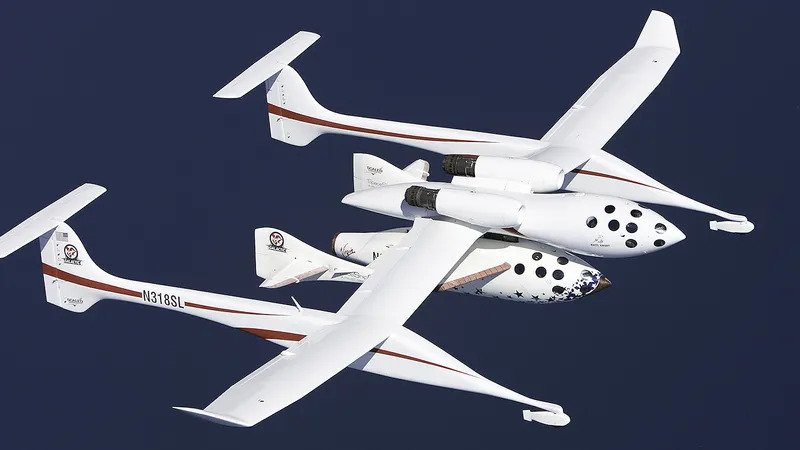
As ridiculous as it is, among the applications submitted to the competition was a Russian one. The boldness of the design exceeded all expectations. It was planned to mount the spacecraft on the back of an M-55 aircraft, designed, among other things, to combat high-altitude reconnaissance balloons, and launch it into space at an altitude of 17 km using rocket boosters. The project was named Cosmopolis-XXI, obviously hinting at the company’s ambitious plans.
But they wisely limited themselves to a good presentation and a plywood model.
They did the right thing. This trash could only fly from the top down, and an attempt to turn on the boosters would most likely have resulted in the crash of the carrier aircraft.
It is a pity that they did not try.
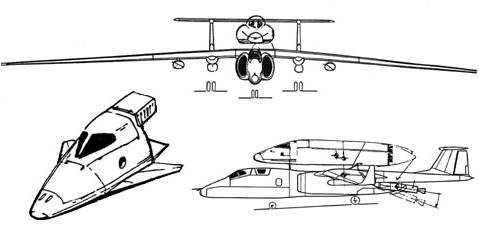
Why is an air launch really a good idea?
“So, what?” someone who has read up to this paragraph may ask in disappointment, “Is there anything good at all about the idea of an air launch?”
There is. It don`t need any spaceport.
The biggest challenge in astronautics is not putting something into orbit — it turned out to be not that difficult. The problem is that there is nowhere to launch from.
A spaceport is not just a powerful (and expensive) launch complex. It is, first of all, thousands of hectares of land on which an emergency rocket, a spent stage, a main fairing, or something else can fall. Toxic fuel is regularly spilled over it. It can be irrevocably contaminated by a radioactive piece of plutonium. You can’t build a settlement or a farm there. It’s not even recommended to get lost in such places, although people do wander there.
All the good places suitable for building spaceports are already occupied. The ones that are not yet occupied are either located in a climate where even a dog would not survive, or there is a nature reserve nearby, or there is a war…
Half of the European countries have the capability to launch craft into orbit, but they don’t have a place. Perhaps they are kicking themselves, regretting their colonies in Africa and the islands. But voters will not understand a return to the era of colonialism, so they live without spaceports.
And there is a way out. It is nearby, or rather, overhead. An airplane can deliver a rocket to a deserted place, favorable in terms of the desired orbital inclination, at a time favorable for the launch window. Then launch it. In the event of an accident, no one is killed, and no debris is “sown” on someone’s property with subsequent compensation. And such a lunch can be insured by an chip insurance company, not an expensive international insurance cartel at the highest rate.
And there is more. During a war, an airplane can operate every day, or even several times a day, as long as the electronics industry has time to rivet radio reconnaissance satellites. Cheap, unreliable, mass-produced, low-orbit, but hovering over the battlefield all the time and taking bearings of every time the enemy go on the air.
Oh, how we lack such an opportunity right now! It’s a pity that all three or even four Ukrainian air launch projects did not find support from the government and investors! Well, now we are paying for this mistake in blood.
However, it’s not too late.
The following articles will be about Ukrainian versions of the air launch systems, and perhaps some of the readers will finally contribute to their realization in metal. Or in a composite. Or in some new nanomaterial.
Let it fly!
Radii Radutnyi, Ukrainian writer
